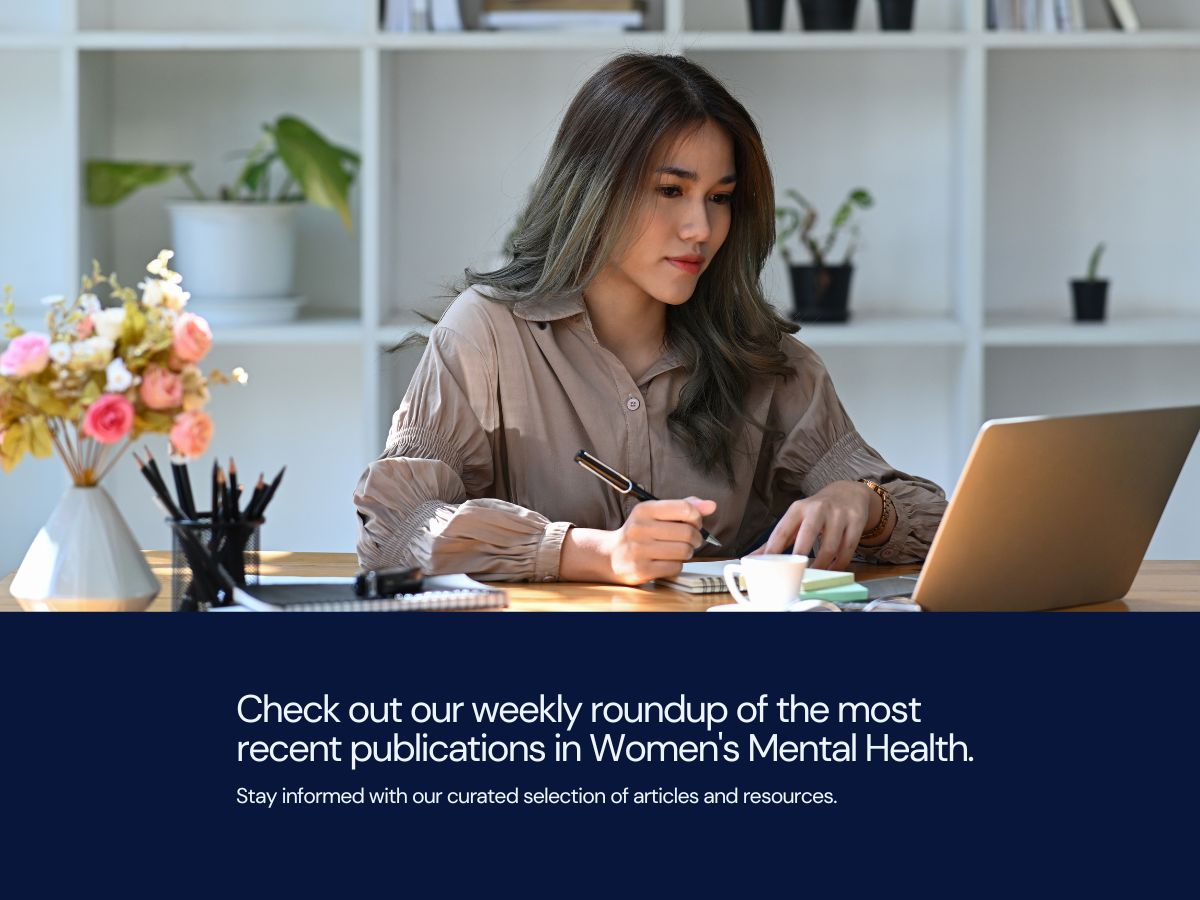
Every week we review the most recent publications in women’s mental health, covering topics related to premenstrual symptoms, perinatal mood and anxiety disorders, use of medications in pregnant and breastfeeding women, perinatal substance use, and menopausal mental health.
For more detailed descriptions of many of these topics, you can sign up to receive our weekly CWMH NEWSLETTER which comes out every Thursday.
Ruta Nonacs, MD PhD
PMS AND PMDD
| No articles this week |
INFERTILITY AND MENTAL HEALTH
| Preconception Stress and Pregnancy Serum Glucose Levels Among Women Attending a Fertility Center
Psychological stress was positively associated with increased glucose levels. |
PSYCHIATRIC ILLNESS DURING PREGNANCY
| Association between adverse childhood experiences and perinatal depressive symptoms: a cross-sectional analysis of 16,831 women in Iceland – PubMed
Total number of ACEs was positively associated with risk for perinatal depression (prevalence ration or PR 1.11 per ACE, 95% CI: 1.10-1.11), also among women without any psychiatric comorbidities. PRs increased in a dose-response manner with the number of ACEs ; women that endorsed 5 or more ACEs were twice as likely to have experienced perinatal depression (PR 2.24, 95% CI: 2.09-2.41). All ACE types (n = 13) were associated with perinatal depression, with most pronounced association for emotional neglect by a guardian (PR 1.53, 95% CI: 1.47-1.59). |
MEDICATIONS AND PREGNANCY
| Monotherapy treatment of epilepsy in pregnancy: congenital malformation outcomes in the child – PubMed
For topiramate, the prevalence of major congenital malformations (MCM) was 3.9% (95% CI 2.3 to 6.5) from cohort study data and 4.1% (0.0 to 27,050.1) from routine health record studies. Risk ratios were significantly higher for children exposed to topiramate in comparison to the children of women without epilepsy in cohort studies (RR 4.07, 95% CI 1.64 to 10.14) but not in a smaller comparison to the children of women with untreated epilepsy (RR 1.37, 95% CI 0.57 to 3.27). Exposure in utero to topiramate was also associated with significantly higher RRs oro-facial clefts. Maternal antipsychotic use during pregnancy and congenital malformations These findings suggest limited or no overall teratogenic effect of first-trimester antipsychotic exposure. Of the 503,158 pregnancies, 1252 (0.2%) were of women who filled an antipsychotic prescription in the first trimester. Major malformations were present in 7.3% of antipsychotic-exposed pregnancies, 5.1% of unexposed pregnancies, and 6.0% of discontinuers’ pregnancies. The adjusted prevalence ratio was 1.14 (95% confidence interval, 0.88-1.48) compared with discontinuers and 1.08 (95% confidence interval, 0.47-2.49) in the sibling analysis. |
POSTPARTUM PSYCHIATRIC ILLNESS
| Effectiveness of two systems-level interventions to address perinatal depression in obstetric settings (PRISM): an active-controlled cluster-randomised trial
The MCPAP for Moms and PRISM interventions were equally effective in improving depression symptoms. Sleep and Postpartum Psychosis: A Narrative Review of the Existing Literature – PubMed It is unclear whether sleep problems are a symptom of, or a trigger for PP. Thus, further research is needed. Digital health interventions reduce postpartum anxiety and depression A systematic review and meta-analysis evaluated 31 randomized trials comparing DHIs to treatment as usual. There’s a new pill for postpartum depression, but many at-risk women face hurdles Among mothers with postpartum depressive symptoms (PDS), most (54%) lived at or below the federal poverty guideline. Mothers who experienced psychosocial stress (e.g., intimate partner violence) during pregnancy had the highest likelihood of reporting PDS (adjusted odds ratio [aOR] = 3.60). Mothers who considered their most recent pregnancy unintended or mistimed were more likely to report PDS (aOR = 1.36; 95% CI, 1.01-1.82), (aOR = 1.65; 95% CI, 1.19-2.27), respectively. Postpartum Depression-New Screening Recommendations and Treatments – PubMed Mother-led infant massage eases maternal postnatal depression, according to studies Women who participate in mother-led infant massage sessions show a reduction in symptoms of postnatal depression. Editorial |
| Association between adverse childhood experiences and perinatal depressive symptoms: a cross-sectional analysis of 16,831 women in Iceland – PubMed
Total number of ACEs was positively associated with risk for perinatal depression (prevalence ration or PR 1.11 per ACE, 95% CI: 1.10-1.11), also among women without any psychiatric comorbidities. PRs increased in a dose-response manner with the number of ACEs ; women that endorsed 5 or more ACEs were twice as likely to have experienced perinatal depression (PR 2.24, 95% CI: 2.09-2.41). All ACE types (n = 13) were associated with perinatal depression, with most pronounced association for emotional neglect by a guardian (PR 1.53, 95% CI: 1.47-1.59). |
| A virtual mother-infant postpartum psychotherapy group for mothers with a history of adverse childhood experiences: open-label feasibility study – PubMed
There were significant pre- to post-group reductions in maternal depressive and post-traumatic symptoms. A higher proportion of mother-focussed interventions [20/30 (66.7%)] brought significant reduction in PPD outcomes as compared to a lower proportion of mother-child focused interventions [4/7 (57.14%)]. Mother-focused mixed approaches [3/3 (100%)] performed better in improving PPD than psychological [16/24 (67%)] or psychosocial approaches [1/3 (33.3%)] alone. Amongst mother-child focused interventions, psychosocial approaches performed well with two-thirds demonstrating positive effects on PPD. |
MEDICATIONS AND BREASTFEEDING
| No articles this week |
PERINATAL SUBSTANCE USE
| Academy of Breastfeeding Medicine Clinical Protocol #21: Breastfeeding in the Setting of Substance Use and Substance Use Disorder (Revised 2023) – PubMed
This protocol provides breastfeeding recommendations in the setting of nonprescribed opioid, stimulant, sedative-hypnotic, alcohol, nicotine, and cannabis use, and SUD treatments and offers guidance on the utility of toxicology testing in breastfeeding recommendations. Breastfeeding and neurodevelopment in infants with prenatal alcohol exposure – PubMed This study found a positive effect of breastfeeding on infant neurodevelopment among infants with prenatal alcohol exposure (PAE), particularly in those exposed to higher levels during gestation. This study is one of the first to evaluate whether breastfeeding mitigates harm caused by PAE. Treatment outcomes among pregnant women with cannabis use disorder – PubMed A relatively high proportion of CUD treatment completion (52%) was observed among pregnant women who had > 1 month of CUD treatment and were referred to the treatment program by the criminal justice system. |
MATERNAL MENTAL HEALTH AND CHILD OUTCOMES
| Mother-infant bonding triggers brain synchronization, according to new neuroscience research – PsyPost |
MENOPAUSE AND MENTAL HEALTH
| No articles this week |
OTHER TOPICS IN WOMEN’S MENTAL HE
| The role of the hypothalamic-pituitary-adrenal axis in depression across the female reproductive lifecycle: current knowledge and future directions
Despite growing evidence about the impact of gonadal hormones on mood disorders, no previous review has examined the interaction between such hormonal changes and the HPA axis within the context of depressive disorders in women. We will focus on HPA axis function in depressive disorders at different reproductive stages. Female-specific pharmacotherapy in ADHD: premenstrual adjustment of psychostimulant dosage The results of this small study concur with previous findings of diminished response to amphetamines in the late luteal phase. Increased dosage may help combat premenstrual worsening of cognitive and emotional symptoms in women with ADHD. Zuranolone – synthetic neurosteroid in treatment of mental disorders: narrative review – PubMed |



Leave A Comment